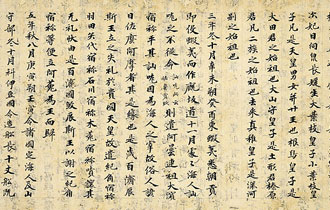Pages |
Kōminka in Taiwan and Korea
During the wartime period, the ultranationalist fervor in the Japanese homeland was reflected in the colonies by the kōminka policy movement. Transitioning from the relatively liberal policies of the 1920s, kōminka policies called for a rapid assimilation of colonial peoples, making them "truly Japanese" not only in deed but in "spirit." For anyone familiar with Japanese wartime discourse, when the term seishin ("spirit") was endlessly repeated, it is not surprising that "spirit" would become the touchstone of the wartime Japanization movement in the colonies. The urgency was due to the expanding scope of the war in the region, a conflict that Japan could not fight alone. Wartime pressures caused Japanese colonial officials to mobilize all colonial resources and manpower, and without the colonial subjects' wholehearted loyalty toward the mother country, such mobilization would be insufficient. The movement to promote the "Japanese spirit" was, therefore, essential to Japan's war effort.
In 1937-38, though, when the war with China began, Japan instituted four new programs to increase its ability to control the colonies. These programs consisted of religious reform, a national language movement, a name-changing campaign, and increased military recruitment.
In terms of religious reform, Japan's colonial governments started to promote State Shinto religious practices while prohibiting the expression of indigenous religions. In Taiwan, Japan built Shinto shrines and encouraged the public to visit them. Colonial administrators also encouraged families to maintain a Shinto altar (kamidana) in each household. In Korea, the policy focused on controlling Christian independence movements. Several Christian mission schools refused to participate in Shinto rituals, and they were consequently shut down. In 1940, Japan cracked down on Christians in Korea, shutting down 200 churches and arresting 70 ministers and around 2,000 church members. More than fifty of the ministers died in jail.
Regarding the control of national languages, in April 1937, the colonial government in Taiwan removed classical Chinese from the elementary and middle school curricula and forbade any use of Chinese in newspapers. The following year, the colonial government in Korea not only removed Korean language education from most schools, it even banned students from using Korean at school at all and discouraged them from using it outside of school. The governments in both Korea and Taiwan promoted the use of Japanese. While in Taiwan there was no attempt to ban the public use of Chinese or other indigenous languages, Taipei Prefecture began a program in 1937 honoring those families who claimed to speak only Japanese in the home. In Korea, however, the colonial government considered the native language a greater threat than Taiwanese was considered by the Taiwan colonial government, and so it worked more actively to ban its use in from public places.
The Taiwan and Korea colonial governments announced in February 1940 a new set of regulations on household registration which encouraged colonial subjects to replace their original names with Japanese ones. In Taiwan, the regulations were not rigidly enforced; but even so, in five years around seven percent of the population had changed their names.
In Korea, however, the name change was mandatory. There, the Japanese used a different rationale. They argued that last names then in use were clan names rather than family names and that Koreans did therefore not have a "modern family system." The requirement to change one's name came into effect in February 1940, and the government gave everyone six months to comply. Richard Kim's autobiographical work, Lost Names, provides a moving representation of the humiliation Koreans felt during this period. Many Koreans responded by dressing in black so as to express their sorrow over the loss of their names and family identities.
Pages |











